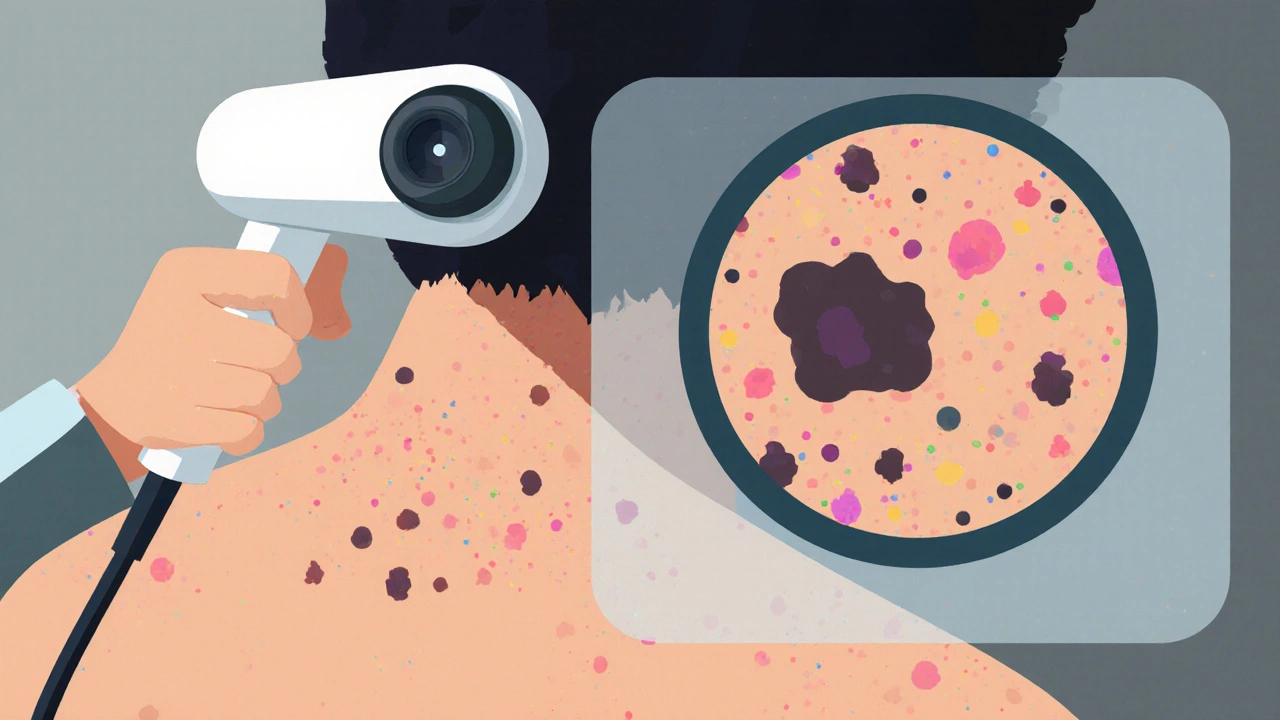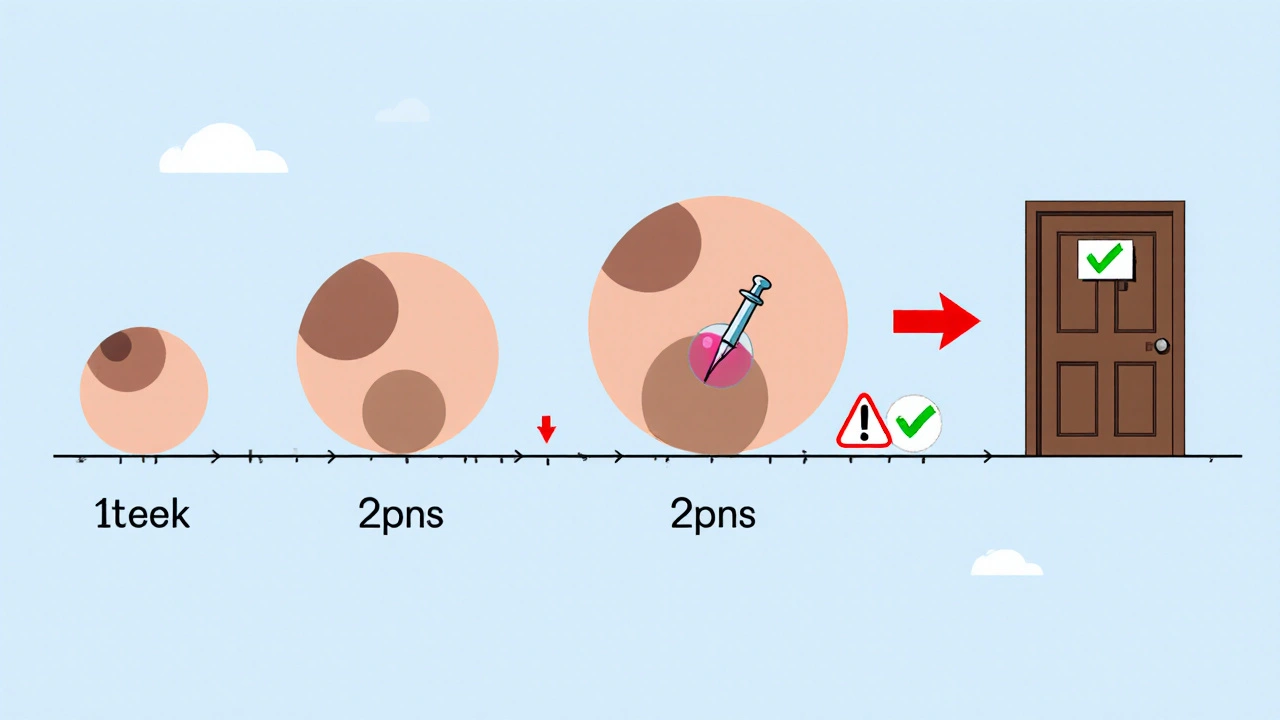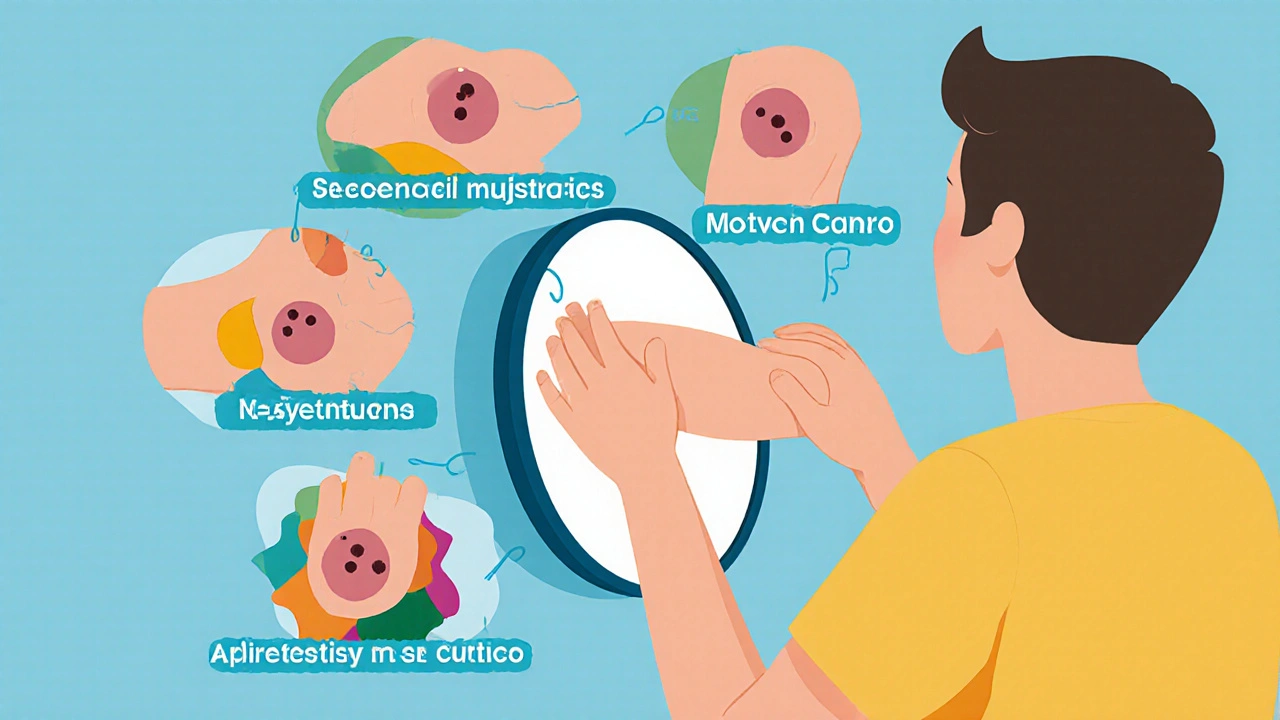Most people have moles. Some have a few. Others have dozens. But not every mole is harmless. The real danger comes when one starts behaving like melanoma - the deadliest form of skin cancer. Catching it early can mean the difference between a simple removal and life-altering treatment. That’s where the ABCDE rule comes in. It’s not perfect, but it’s the best tool most people have to spot trouble before it spreads.
What the ABCDE Rule Actually Means
The ABCDE rule breaks down warning signs into five simple letters. Each one points to a visual clue that a mole might be turning cancerous.- A for Asymmetry: Draw an imaginary line through the middle. If the two halves don’t match, that’s a red flag. Normal moles are usually round or oval and symmetrical.
- B for Border: Healthy moles have smooth, even edges. Melanomas often look jagged, notched, or blurry at the edges - like they’re bleeding into the skin.
- C for Color: A mole with more than one shade is suspicious. Think dark brown, black, red, white, or blue all in one spot. Even a single dark spot on a light mole can be dangerous.
- D for Diameter: The old rule said 6 millimeters - about the size of a pencil eraser. But now, experts say to pay attention to anything larger than 5 mm, or anything darker than your other moles, even if it’s smaller.
- E for Evolving: This is the most important one. If a mole changes over weeks or months - growing, itching, bleeding, or changing color - don’t wait. Get it checked.
These aren’t just guidelines. They’re based on data from thousands of cases. A 2022 study found that when a mole showed three or more of these signs, it had an 85% chance of being melanoma. But here’s the catch: not all melanomas follow the rules.
Why the ABCDE Rule Can Miss Melanoma
Many people think if their mole doesn’t fit ABCDE, it’s safe. That’s a dangerous assumption.A 2022 study in the Journal of the American Academy of Dermatology looked at 144 melanoma cases. Nearly a third were in situ - meaning they hadn’t spread yet. Of those early cancers, only 33% showed the classic “E” sign of evolution. That means almost two out of five melanomas were changing, but not in ways people notice.
Some melanomas are symmetrical. Some are small. Some are one solid color. One type called desmoplastic melanoma - which often appears as a scar-like bump - shows ABCDE features in just 15% of cases. Childhood melanoma? Only 18% fit the pattern.
And then there’s the ugly duckling sign. This isn’t in the ABCDE rule, but it’s just as important. It means one mole looks completely different from all the others on your body. It might be darker, larger, or just feel wrong. A 2019 study found this sign caught 73% of melanomas that ABCDE missed.
One Reddit user, u/SkinCancerSurvivor, shared: “My melanoma was perfectly symmetrical, uniform color, and only 3mm. None of the ABCDE criteria applied. It was stage IIB.” That’s not rare. In fact, a 2022 American Academy of Dermatology survey found that 42% of people waited to see a doctor because their mole “didn’t meet enough ABCDE criteria.” The average delay? Over seven months.

When to Get a Biopsy - It’s Not Just About ABCDE
Doctors don’t decide to biopsy a mole just because it ticks off three ABCDE boxes. They look at the whole picture.Here’s what actually pushes a mole toward biopsy:
- It’s changed noticeably in 3-6 months - size, shape, color, texture.
- It’s the ugly duckling - standing out from all your other moles.
- It’s bleeding, itching, or crusting without injury.
- It’s growing fast - noticeable even to someone who doesn’t know the ABCDE rule.
- You have a personal or family history of melanoma.
A 2022 survey of 350 dermatologists found that 67% use digital dermoscopy - a magnified skin scanner - to help decide. This tool boosts accuracy from 75% to 92%. But you don’t need it. You just need to notice change.
Doctors also look at your skin type, sun exposure, and number of moles. If you have over 50 moles, or a history of sunburns, your risk goes up. That’s why even a small, normal-looking mole might get removed if you’re high-risk.
And here’s something most people don’t know: some biopsies are done just because the patient is worried. If you say, “This mole feels different,” and your doctor can’t explain why it’s safe, they’ll biopsy it. Your instinct matters.
The Cost of False Alarms - And Why They’re Still Worth It
Biopsies aren’t cheap. A 2022 study in JAMA Internal Medicine found that for every melanoma caught using ABCDE, nearly five benign moles were removed. That adds up to $417 million a year in the U.S. alone.But here’s the trade-off: melanoma kills. When caught early - stage 0 or stage I - the five-year survival rate is 99%. By stage IV, it drops to 32%. That’s not a risk you want to gamble on.
And the number of cases keeps rising. The American Cancer Society expects over 100,000 new melanoma cases in 2024. The rate has been climbing 3.1% every year since 1992.
So while the system isn’t perfect, it’s working. More people are checking their skin. More dermatologists are using tools like dermoscopy and AI. And more early cancers are being found.

What You Can Do Right Now
You don’t need a dermatologist to save your life. You just need to know what to look for - and act fast.- Check your skin once a month. Use a mirror, or ask someone to help with your back, scalp, and between your toes.
- Take photos of your moles every few months. Compare them. Even a phone camera works.
- If you see a mole that’s changing, bleeding, or just feels off - go to a doctor. Don’t wait for it to look “classic.”
- Know your risk. Fair skin, lots of sunburns, family history? Be extra careful.
- Don’t ignore the ugly duckling. One mole that’s different? That’s enough reason to get it checked.
There’s no magic test. No app replaces a doctor. But if you notice a mole changing - even slightly - get it looked at. The ABCDE rule isn’t the final word. It’s the starting line.
What’s Next for Melanoma Detection
The future is digital. AI tools are now being used in 43% of U.S. dermatology clinics. One FDA-approved app, SkinVision, uses ABCDE plus machine learning to analyze moles from photos. In trials, it caught 95% of melanomas.Some clinics are even using genetic tests on small skin samples to tell if a mole is dangerous without cutting it all out. These tests are still new, but they’re helping reduce unnecessary biopsies by over 30%.
By 2027, experts predict the ABCDE rule will still be taught - but it’ll be just one part of a bigger system: photos, AI, dermoscopy, and doctor judgment working together.
For now, though, you don’t need any of that. You just need to know your skin. And if something looks wrong - trust yourself. Get it checked.
Can a mole be cancerous even if it’s small?
Yes. While melanomas are often larger than 6 mm, about 30% are found when they’re smaller than that. Size alone isn’t a reliable indicator. A small mole that’s changing color, bleeding, or looks different from others should be checked.
Do I need to check moles I’ve had for years?
Yes. Melanoma can develop in a mole that’s been there for decades. The key is change. If a mole you’ve had for 10 years suddenly starts itching, darkening, or growing, it needs evaluation - even if it’s always looked normal before.
Is the ABCDE rule reliable for children?
Not always. Childhood melanomas often don’t follow the ABCDE pattern. In fact, only about 18% of melanomas in kids show classic signs. Look for moles that are growing fast, changing color, or look different from others. Any new or changing spot on a child’s skin should be evaluated by a doctor.
What if my mole doesn’t match any ABCDE signs?
Don’t assume it’s safe. About 20-30% of melanomas lack classic ABCDE features. If a mole feels unusual - itches, bleeds, or just looks wrong - get it checked. Your instinct matters more than the checklist.
How often should I get a professional skin check?
If you have no risk factors, a full-body skin exam every 1-2 years is enough. If you have many moles, a personal or family history of melanoma, or a history of sunburns, get checked every 6-12 months. High-risk individuals should also do monthly self-checks.







Been checking my moles monthly since my cousin got diagnosed. Took a pic of one on my back last month - noticed it got a tiny bit darker. Went to the derm, turned out it was just a weird freckle. Still glad I checked. Don’t wait for the checklist. Trust your gut.
Y’ALL. I’m not a doctor but I’ve seen too many people ignore their skin like it’s a glitch in a video game. ABCDE is a STARTING POINT, not a free pass. That mole you’ve had since college? If it’s suddenly itchy as hell and looks like it’s trying to escape your skin - GO. NOW. Your future self will thank you. No excuses.
My grandma had 80 moles. Every year she’d go in, doc would take pics, compare. One year one looked normal but felt weird - like it was raised under the skin. Biopsy came back stage I. She’s fine now. Point is: if it feels off, even if it looks fine - get it checked. No shame in being cautious.
ABCDEF? No. Just ABCDE. And even that’s overrated. Most people can’t tell asymmetry from a potato. You don’t need a rule. You need to stop being lazy. If you don’t know what a mole looks like on your own body, you deserve to get cancer.
It’s interesting how the article emphasizes personal intuition, yet ignores the systemic barriers to care. Access to dermatologists is not equitable. Many cannot afford biopsies, even if they ‘feel’ something. The burden of vigilance is placed on the individual, while structural neglect persists.
The ABCDE rule is a heuristic derived from population-level statistical patterns, not a diagnostic algorithm. Its utility lies in raising awareness, not in replacing clinical judgment. The 2022 JAAD study cited indicates a significant proportion of in situ melanomas lack evolving features, suggesting that temporal monitoring may be more critical than static visual analysis. Furthermore, the ugly duckling sign, while empirically validated, remains underutilized in public education campaigns due to its subjective nature. This represents a gap between evidence-based dermatology and public health messaging.
why do americans make everything so complicated? in india we just look at mole if it looks bad we go to doctor. no abcde no ugly duckling no ai apps. just common sense. also why you guys have so many moles? maybe stop eating sugar and sunbathing like idiots
My uncle in Punjab had a mole for 30 years. One day it started bleeding. He went to the local clinic - they said it was fine. He came to the US, got it checked - melanoma stage II. He’s fine now. Don’t wait for a fancy rule. If it changes, get it checked. No matter where you’re from. Your life matters more than waiting.
My mom got her first biopsy at 68 because she said ‘it just felt wrong.’ Turned out it was early melanoma. She’s been fine for 5 years now. I started checking my skin after that. I don’t need to know the ABCDE rule - I just need to know what my body looks like. And if something feels off? I don’t wait. I go.
Ugh. Another ‘trust your gut’ post. My gut says people who don’t get professional skin checks are dumb. AI apps? They’re garbage. Dermoscopy? Only works if you have a $10k machine and a $500/hour doc. Meanwhile, people are posting selfies with moles on TikTok like it’s a beauty filter. Wake up. This isn’t a meme. It’s cancer. And you’re playing Russian roulette with your skin.
I appreciate the emphasis on the ugly duckling sign. I’ve always relied on that instinct - one mole on my shoulder just looked… alien. Not darker, not bigger - just wrong. My derm said it was the most telling sign I’d ever shown him. He removed it. Turned out to be a very early melanoma. I didn’t know ABCDE. I just knew it didn’t belong.
From a clinical perspective, the ABCDE criteria demonstrate moderate inter-rater reliability (kappa ~0.55), which limits their utility in primary care settings without dermoscopic adjuncts. The emergence of deep learning models trained on dermoscopic datasets has shown superior sensitivity (95.2%) and specificity (88.7%) in recent meta-analyses, suggesting a paradigm shift toward algorithm-assisted triage. However, these technologies remain inaccessible to underserved populations, exacerbating disparities in early detection.
Look I’ve been saying this for years - the whole ABCDE thing is a scam created by big pharma to sell biopsies. Most moles are fine. You’re scared because you watch too many medical dramas. My cousin had 12 biopsies in 3 years - all negative. He lost $20k and got scar tissue. Stop being paranoid. Just don’t pick at them.
bro i have a mole on my neck that’s been there since i was 12. it’s kinda big but it’s always been the same color. i’ve been meaning to get it checked but i keep forgetting. should i be worried? or am i just being dumb?
One cannot help but observe the profound epistemological inadequacy of the ABCDE heuristic as a public health instrument. It is a reductionist schema, born of epidemiological convenience, not diagnostic precision. The reliance on visual morphology - a phenomenon subject to inter-individual perceptual variance - is, in the context of melanoma, not merely insufficient; it is dangerously archaic. The future of oncological detection lies not in layperson observation, but in molecular profiling, genomic sequencing, and AI-driven dermatoscopic analytics. To instruct the public to rely on a 1980s mnemonic is not education - it is negligence dressed as empowerment.